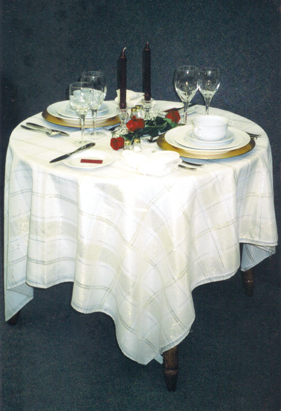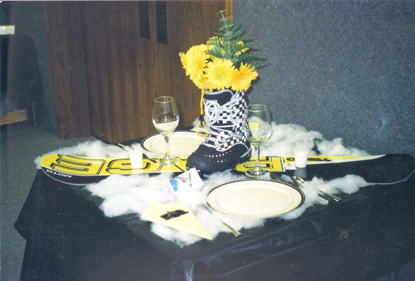Design a Table
 Hard to realize its planning time again for the new school year. I will soon post some details about one of my favorite assignments where we combine art and protocol lessons. Its fun, creative, and introduces students to proper table settings as well as good design principles. Give me another week and I’ll share some past project photos (hopefully). You will find the table top ideas and assignment suggestions helpful for the teenagers in your protocol matters…it may rekindle the creative spark in your dining room, too. A theme table adds zest to any party.
Hard to realize its planning time again for the new school year. I will soon post some details about one of my favorite assignments where we combine art and protocol lessons. Its fun, creative, and introduces students to proper table settings as well as good design principles. Give me another week and I’ll share some past project photos (hopefully). You will find the table top ideas and assignment suggestions helpful for the teenagers in your protocol matters…it may rekindle the creative spark in your dining room, too. A theme table adds zest to any party.
—————————–
a bunch of photos:
8-19-2009-place_setting_colorful_bd08383_.jpg
8-19-2009-hispanic.jpg
8-19-2009-2-hispanic.jpg
8-19–009-photo-table.jpg
8-19-2009-rose.jpg
8-19-2009-linen.jpg
8-19-2009-ahab.jpg
Aug-19-2009
Design a Table
Posted by sandra in Table setting ideas, Establishing Protocol in Homes, Establishing Protocol & Etiquette in Schools, Dining Details
Want to make table etiquette come more alive for your teenagers? This project familiarizes them with correct table settings plus teaches art’s principles of organization as they each design their own table top.
It’s a great way to learn about art’s practical application plus remember how and what goes where in proper placement and use of tableware. Students come up with some outstanding tables.
Here’s what we do, but you can tailor the process to fit your situation, whether classroom or home school. I assign teams of two classmates and after a few instructions, turn them loose to create a table setting with a theme of their choice. Dialectic and rhetoric level students always pursue this project with gusto.
Of course we have perimeters, but not to many in this creative process. You should see some of their tables–and in fact you will if you read more, thanks to one of our moms (Mrs. Milner) who takes great photos and keeps track of them better than I do with mine.

“Design a Table” Guidelines:
A card sized table must be correctly set according to either a formal or semi-formal category (their choice) with two to four place settings with a table cloth and napkins. In class we review proper placement (there are diagrams in the Protocol Matters book). The table must have a centerpiece and place cards for each “guest”. Students are responsible for supplying all materials and the card table. Chairs are optional, not required, in the project set up.
The sky’s the limit for themes and can be based on famous people, historic events, hobbies, sports, nations, or time periods. Some very unique tables come forth. A few past designs that spring to mind include a jungle motif with Tarzan and Jane as honored guests, a Japanese low table with the Emperor and Empress as honored guests, and a quaint Victorian table. In the accompanying photos you’ll see a few past themes inspired by sports, history, and other cultures…even a sea world theme, complete with live fish as part of the centerpiece.
Students notify me (in writing) of their chosen theme within a week after receiving this assignment.The first written notice received for a certain theme has exclusive rights to that particular theme, and no one else can use it.This is fun and spurs their creative competitive souls to action.
Next in class, after review of proper tableware placement, we discuss art’s principles of organization. This helps students better understand how to arrange their items in an eye appealing way. We discuss how a good composition strives for harmony of items, pleasing proportional relationship, some variety, skillful use of repetition, movement to guide the eye, certain amount of contrast whether by color, texture or size, dominance (likely the centerpiece on a table), and balance.
Good and bad examples of each principle help students recognize their application and usefulness. For example, repetition flows in matching plates, contrast comes from varied colors used, and dominance of a well proportioned centerpiece won’t dwarf or overpower the place settings.
Students see that when it comes to the applied arts, form definitely follows function and many of the principles of arrangement fall quite easily into place.
This is a good project to assign several months before a protocol event. I also try to time this project so it is completed and be set up for display during special school events such as Grandparent’s day or parent’s open house. I also found it helpful to post “do not touch” signs near the tables when on display… not so much for visitors but to remind other younger students that this is a “look only” display. Signs remind little hands to resist temptation’s urge to handle or move items on the tables…touching increases the possibility of damage or breakage, much to the consternation of the designers who are quite pleased with their table creations.
I’m delighted with the effectiveness of this project … and I think you will like it too. Nothing beats the hands on approach for learning. The guys enjoy it as much as the girls. Much more inspiring than a mere lecture.

Bright colors set the festive mood in this south of the border motif..aren’t the somberos on the chairs a good touch. The cactus centerpiece is a bit off scale because its proportions are too small when placed next to the plates and cloth’s large striped pattern.

Graduation celebration theme features the centerpiece’s effective use of repetition with the strong gold candles…they are big, but proportionately scaled to the goblets and plates.

Candlelight dinner for two with red roses in a well balanced and low contrast setting says this is a special formal occasion. The round table increases the sense of fellowship.

Seaside dinner with beach towels for table cloth and seashells in the glass centerpiece plus beach robe and sunglasses and lotion for honored guests. Harmony occurs through similar hues. Contrast is provided by towel’s texture in this monochromatic color scheme.

Snowboarder theme has a happy mood enhanced by good use of yellow contrasted against black and white. While the snow may prove challenging for hungry diners, it re-inforces the theme so no points off.

Here’s Seaworld, complete with live fish in the glass centerpiece. Captain Ahab is honored and pleased. The colorful cloth napkins add balance and the woven mats finish off this student team’s first protocol and art experience in Design a Table.
Hope you find this post helpful …I would like to see some of your tables if you do this project. Sharing ideas helps all of us in training up our children, which is really a most enjoyble task–and I might add, a very important one. They mustn’t be left to themselves to grapple in the dark. Don’t underestimate the need for equipping them with decent manners and gracious social skills. Simple things like good table etiquette impacts their character. I love learning and growing together in right directions. Protocol training helps us in this regard –thus protocol matters!